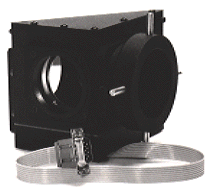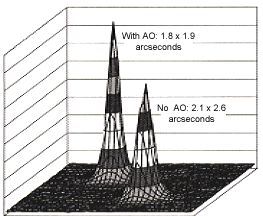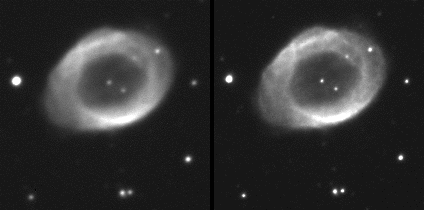S.B.I.G. Adaptive Optics System Introduction; September 1997

Illustration 1. Model AO-7 Adaptive Optics Module (shown without optional CCD Camera)
The Model AO-7 Adaptive Optics system has two components:
- a high speed tip-tilt mirror system for atmospheric correction, and
- new image enhancement software implementing the Lucy-Richardson algorithm.
TIP-TILT HIGH SPEED GUIDING:
Utilizing the second guiding CCD as an imaging sensor, the guide star's position is read out at rates of up to 40 times a second, and then the tip-tilt mirror adjusted to hold the star on the designated pixel for the length of the imaging CCD's exposure. The tip-tilt mirror moves and settles to within 20% of the commanded position in a mere 10 milliseconds, a dramatically faster response than any telescope drive is capable of achieving. The result is sharper more pinpoint stars, and more clearly defined nebular features. As a general rule one can guide at 10 frames a second on a 10th magnitude star with a 10 inch (25 cm) telescope.
The range of the mirror for the model ST-7 is +/- 50 pixels or 2 arcminutes of correction with an 80 inch focal length, enough to accommodate the periodic error of many mounts without bothering to correct the RA drive axis directly. The Model AO-7 can do all the guiding. Inexpensive telescope mounts are now entirely capable of producing well guided images. SBIG has enclosed a product photograph and a surface plot showing the relative brightness of two stars with and without the adaptive optics system operating.

Illustration 2. AO-7 Surface plot showing relative differences of brightness between two stars.
LUCY-RICHARDSON IMAGE ENHANCEMENT:
SBIG, in association with accomplished astrophotographers Benoit Schillings and Brad Wallis, has developed a "Lucy-Richardson" image sharpening software application that produces dramatic improvements in image detail, visually a 2x improvement. The algorithms used are similar to those used on the Hubble Space Telescope images. The results are the best we have ever seen from amateur telescopes.
The enhancement program is Windows 95 compatible (or Macintosh Power PC if operating a Windows 95 emulator), and resembles SBIG's new Windows processing products, not the well known SBIG "CCDOPS" which runs in the DOS environment. In addition to the enhancement capability, the program allows the display of multiple images, modification of background and range to enhance visibility of detail on the monitor, a crosshairs mode for inspecting pixel values, negative image display mode, and horizontal and vertical image flip.
The AO-7 system can be easily retrofitted to all of the Model ST-7 and ST-8 series dual chip CCD imaging cameras by inserting a new ROM and loading the upgraded software that accompanies the system. This can be easily done by the user at his site. This remarkable system promises to have a profound effect on CCD imaging by reducing the atmospheric turbulence, wind induced vibrations, and eliminating the remaining periodic errors in most telescopes drives.
Please note that the AO-7 system will only operate with the Models ST-7 and ST-8 dual CCD imaging cameras.
The image below shows a 5 minute image of the Ring Nebula taken with an ST-7 attached to a Celestron C-11 Schmidt-Cassegrain telescope at prime focus (efective focal length = 110 inches). The image on the left was taken by "Self Guiding" the Losmandy G-11 mount with a 1 second tracking rate. The image on the right utilized the Model AO-7 with a 0.05 second tracking rate, and then was post processed with the Lucy Richardson software (CCDSHARP).

Illustration 3. Ring Nebula taken with an ST-7 attached to a Celestron C-11 Schmidt-Cassegrain telescope, at right with AO-7.
Contents Copyright 1994-2000 Company Seven - All Rights Reserved